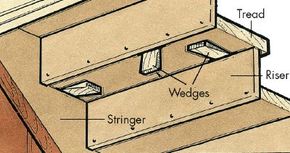How to Remove Squeaks in Stairs
Squeaky stairs sometimes can be fixed quickly with packaged graphite powder or talcum powder in a squeeze bottle. Apply the powder along all the joints in the area of the stair squeaks. The powder lubricates the edges of the boards and might take away the noise. If that fails, you'll need to look into the following more permanent methods.
Stairs are put together with three basic components: the tread, the riser, and the stringer (the side piece). In most cases, stair squeaks are caused by the tread rubbing against the riser or the stringer. If you can, work from under the stairs when fixing a stair squeak. You'll need a helper to walk up and down the stairs while you work.
Advertisement
While your helper walks on the stairs, watch them from below, looking for movement and for cracks in the wood, loose nails, or other problems. One of the simple ways to fix a stair squeak is to wedge the components that are moving. Cut small wedges from wood shingles or shims. To install a wedge, apply carpenters' glue to the side that will lie against the stairs. Drive the wedge into the squeaking joints, either tread-riser or tread-stringer. When the wedge is tight, secure it with small nails, being careful not to split the wedge. The nails must be long enough to hold the wedge securely, but make sure they don't go all the way through the stair component and stick out on the other side.
If the joints aren't wide enough to take wedges, use 1x2-inch wood braces to stop the movement of the boards. Use one long or two or more short 1x2 blocks for each stair-width joint. Apply carpenters' glue to the sides of the block that will lie against the stairs, then set the block into the squeaking joint and nail it into place.
If you can't get at the stairs from underneath, work from the top. For stair squeaks at the front of a tread, where it meets the riser below it, drive pairs of spiral flooring nails, angled toward each other in a V, across the tread and into the top of the riser. Countersink the nail heads with a nail set, and cover them with wood filler.
For squeaks at the back of a tread, where it meets the riser above, apply carpenters' glue to thin wedges, and use a hammer and a wood buffer block to pound them in. Then carefully trim the wide ends of the wedges flush with the riser. If the wedges are noticeable, cover the joint with quarter round or other trim molding; treat all other joints the same way so they match.
